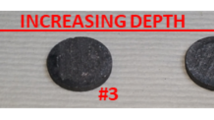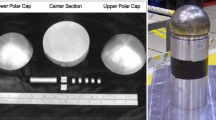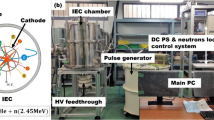Abstract
We have proposed a new concept of the “self-indication method” combined with neutron resonance densitometry (NRD) for nondestructive assaying of the distribution of nuclear materials in the fuel debris of Fukushima Daiichi NPP. To verify the method, we performed experiments using a 46 MeV electron linear accelerator at the Kyoto University Research Reactor Institute. First, we measured the area densities of gold foil 10, 20, 30, 40, and 50 μm thick by area analysis at the 4.9 eV resonance region. It was confirmed that the area densities of the target nuclide can be determined by conventional NRD and the self-indication method within 3 % accuracy, respectively. As the next step, we added a silver foil of 50 μm thickness to a gold foil of 10 μm thickness and measured the area density of the gold foil. It was shown that the contribution from the other nuclide (silver foil) can be remarkably suppressed by applying the self-indication method. Finally, we have demonstrated a nondestructive assay of nuclear material using a mixture composed of a natural uranium foil, sealed minor actinide samples of 237Np and 243Am. The results indicated that the self-indication method is useful for assaying a mixture of materials with high activity such as fuel debris.
You have full access to this open access chapter, Download chapter PDF
Similar content being viewed by others
Keywords
1 Introduction
It is surmised that melted fuel debris is present in the cores at units 1, 2, and 3 of Fukushima Daiichi NPP. Identifying the fuel debris status in the reactors is one of the most important issues for decommissioning. Therefore, we need to determine how to analyze the properties of actual debris collected from those cores in advance of removal work. As the debris contains melted fuel and cladding tube and structure materials heterogeneously in addition to salt content, nondestructive assaying of the distribution of nuclear materials within the debris is absolutely essential for nuclear material accountancy and critical safety.
Neutron resonance densitometry (NRD) [1] with the time-of-flight (TOF) technique based on neutron resonance transmission analysis (NRTA) [2] and neutron resonance capture analysis (NRCA) [3, 4] is a promising way to characterize the debris. However, there are two difficulties in applying those methods to fuel debris. In NRD, many resonances of other nuclides that are contained in the debris may make it difficult to identify and quantify the target nuclide. In NRCA, it is expected that the intense decayed gamma rays from debris result in high background and large dead time of the gamma-ray detector. In this work, we propose a new concept of the “self-indication method” as a complementary assay to overcome those difficulties. In the self-indication method, we set an indicator consisting of target nuclide with a high purity at the beam downstream from a sample. By detecting the reaction products such as neutron capture γ-rays or fission products from the indicator with the TOF method, the transmission neutron can be measured indirectly. The self-indicator is a transmission neutron detector that has high efficiency around the objective neutron resonance energies of the target nuclide, enabling us to quantify effectively the amount of resonance absorption of the target nuclide. Moreover, it is not easily affected by the decayed γ-rays from the debris.
In this work, experimental validation for application of the self-indication method was carried out. A part of the preliminary results is shown in this chapter.
2 Experiment
To verify the self-indication method, we have performed three kinds of experiments using a 46 MeV electron linear accelerator (linac) at the Kyoto University Research Reactor Institute. The experimental arrangement is shown in Fig. 3.1. Pulsed neutrons were produced from a water-cooled photo-neutron target assembly, 5 cm in diameter and 6 cm long, which was composed of 12 sheets of tantalum plates with total thickness of 29 mm [5]. This target was set at the center of an octagonal water tank, 30 cm long and 10 cm thick, as a neutron moderator. The linac was operated with a repetition rate of 50 Hz, a pulse width of 100 ns, a peak current of 5 A, and an electron energy of about 30 MeV. We used a flight path in the direction of 135 ° to the linac electron beam. To reduce the gamma flash generated by the electron burst from the target, a lead block, 7 cm in diameter and 10 cm long, was set in front of the entrance of the flight tube.
First, a gold foil 10, 20, 30, 40, or 50 μm thick was located as a sample at a flight length of 11.0 m, where the neutron beam was well collimated to a diameter of 24 mm. An indicator located at a flight length of 12.7 m was surrounded by a Bi4Ge3O12 (BGO) assembly, which consists of 12 scintillation bricks each 5 × 5 × 7.5 cm3 [6]. Prompt-capture γ-rays from the indicator were detected with the BGO assembly in the TOF measurement. A 10B plug 8 mm thick or gold foil 50 μm thick was used as an indicator. Because the former thick indicator can absorb most neutrons with energies below the epi-thermal region, it was equivalent to the conventional NRTA. In the latter case, it was the self-indication measurement. The area densities of the samples with different thickness were estimated by area analysis for the 4.9 eV resonance of 197Au.
As the next step, a 50-μm-thick silver foil was added to a 10-μm-thick gold foil to form a sample and the area density of the gold foil was measured. It is worth noting that silver has a large resonance at 5.2 eV, close to the 4.9 eV resonance of 197Au. The 10B plug 8 mm thick or a gold foil 50 μm thick was also used as an indicator. Moreover, we demonstrated a nondestructive assay for nuclear materials using a mixture composed of a natural uranium plate and sealed minor actinide samples of 237Np and 243Am. The natural uranium plate was 10 × 20 mm2 and weighed 5.8 g. The samples of 237Np and 243Am were oxide powder, which was pressed into a pellet 20 mm in diameter and encapsulated in an aluminum disk-shaped container 30 mm in diameter with 0.5-mm-thick walls. The activities of 237Np and 243Am were 26 and 868 MBq, respectively. In the third measurement, the 10B plug 8 mm thick or a natural uranium plate of 10 × 20 mm2 and weight 5.8 g was used as an indicator.
3 Results and Discussion
The TOF spectra obtained by both methods, NRTA (dotted lines) and the self-indication method (solid lines), around the 4.9 eV resonance of 197Au are shown in Fig. 3.2. Neutron absorption resulting from the 4.9 eV resonance of 197Au can be observed as a dip and a lack of peak for the NRTA and the self-indication method, respectively. Here the net area ratio R, which is defined as the ratio of resonance absorption to the number of incident neutrons, is defined by
where C i is the net counting rate of the i th channel in the TOF measurement and the subscripts “in” and “out” mean “with” and “without” sample. Background events were estimated by TOF measurement without an indicator and subtracted from the foreground TOF spectrum. The 4.9 eV resonance peak ranges from the I min th to I max th channel. The net area ratios for the NRTA and the self-indication method can be expressed as follows:
where n and n ind denote the thickness (the number of target nuclide per unit area) of the sample and indicator, respectively. The quantities σ tot and σ cap represent the energy-dependent neutron total and capture cross sections of the target nuclide, respectively. The integration is performed over the resonance peak region. By applying Eqs. (3.2) and (3.3), the relationships between the net area ratio and the thickness were obtained using point-wise cross-section data of JENDL-4.0 [7], as shown in Fig. 3.3. If nσ tot is not large, the net area ratio is proportional to the sample thickness. However, it converges to unity and loses information about thickness as nσ tot becomes larger. The thickness of each gold foil sample was derived from the relationship of Fig. 3.3 and the value of R was determined by experiment. Figure 3.4 shows the results of quantitative examination. It was confirmed that the thickness of the target nuclide can be determined by both methods within 3 % accuracy. The accuracy can be improved further by using a smaller resonance (nσ tot is not large).
The TOF spectra with silver and gold samples are shown with the NRTA method in Fig. 3.5 and with the self-indication method in Fig. 3.6. In NRTA, the dips of the 4.9 eV resonance of 197Au and the 5.2 eV resonance of 109Ag overlapped around 400 ch. in Fig. 3.5. In the self-indication method, the contribution from impurity was suppressed and a weak 58 eV resonance of 197Au was emphasized around 120 ch. (Fig. 3.6). The TOF spectra for the mixture composed of natU, 237Np, and 243Am are shown in Figs. 3.7 and 3.8. Although many resonance dips caused by impurities of 237Np and 243Am were observed (Fig. 3.7), there are no differences between TOF spectra with only natU (blue line) and the mixture (red line) (Fig. 3.8). This result indicates that the self-indication TOF spectrum was not greatly influenced by nuclide impurity. It was experimentally shown that the contribution from the other nuclide can be remarkably suppressed by applying the self-indication method.
4 Summary
In this work, we proposed a new concept of the “self-indication method” as a complementary nondestructive assay for the fuel debris of Fukushima Daiichi NPP. We carried out experimental validation for application of the self-indication method. It was confirmed that the area density (thickness of the target nuclide) can be determined within 3 % accuracy by simple area analysis without a resonance fitting process. Moreover, it was experimentally shown that the contribution from the other nuclide can be remarkably suppressed by applying the self-indication method. The self-indication method combined with the TOF technique will be a useful tool for nondestructive assaying of the distribution of nuclear material in the melted fuel debris, which contains many impurities and has high activities.
References
Postma H et al (2001) Radioanal Nucl Chem 248:115–120
Behrens JW, Johnson RG, Schrack RA (1984) Nucl Technol 67:162–168
Kiyanagi Y et al (2005) Measurement of eV-region pulse shapes of neutrons from KENS thermal neutron source by a neutron resonance absorption method. J Nucl Sci Technol 42(3):263–266
Pietropaolo A et al (2010) A neutron resonance capture analysis experimental station at the ISIS spallation source. Appl Spectrosc 64(9):1068–1071
Kobayashi K et al (1987) KURRI-Linac as a neutron source for irradiation. Annu Rep Res Reactor Inst Kyoto Univ 22:142
Yamamoto S et al (1996) Application of BGO scintillators to absolute measurement of neutron capture cross sections between 0.01eV to 10eV. J Nucl Sci Technol 33:815
Shibata K et al (2011) JENDL-4.0: a new library for nuclear science and engineering. J Nucl Sci Technol 48:1
Acknowledgments
This work was supported by JSPS KAKENHI Grant Number 24760714.
Author information
Authors and Affiliations
Corresponding author
Editor information
Editors and Affiliations
Rights and permissions
Open Access This chapter is distributed under the terms of the Creative Commons Attribution Noncommercial License, which permits any noncommercial use, distribution, and reproduction in any medium, provided the original author(s) and source are credited.
Copyright information
© 2015 The Author(s)
About this chapter
Cite this chapter
Hori, Ji., Sano, T., Takahashi, Y., Unesaki, H., Nakajima, K. (2015). Development of Nondestructive Assay to Fuel Debris of Fukushima Daiichi NPP (1): Experimental Validation for the Application of a Self-Indication Method. In: Nakajima, K. (eds) Nuclear Back-end and Transmutation Technology for Waste Disposal. Springer, Tokyo. https://doi.org/10.1007/978-4-431-55111-9_3
Download citation
DOI: https://doi.org/10.1007/978-4-431-55111-9_3
Published:
Publisher Name: Springer, Tokyo
Print ISBN: 978-4-431-55110-2
Online ISBN: 978-4-431-55111-9
eBook Packages: Earth and Environmental ScienceEarth and Environmental Science (R0)












